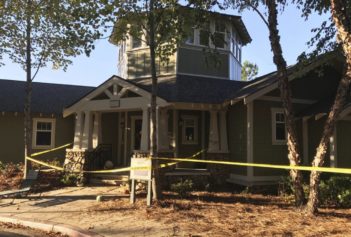
Clemson University trustees turn shovels at groundbreaking ceremony Tuesday. Photo by Ron Barnett
In an effort to address the not so pretty parts of its past, Clemson University held a groundbreaking ceremony Tuesday for a marker that will be placed near the previous residence of former laborers and enslaved workers.
The ceremony comes just one day after a banner commemorating Black history was defaced with a bunch of bananas. The students who committed the act have since turned themselves in.
The research of associate English professor Rhondda Robinson Thomas led to the revelation of how prisoners demolished old slave quarters on the Calhoun plantation and used stones to construct some of the university’s earliest structures. The markers are meant to serve as indicators of the role slavery played in the school’s history.
A sign acknowledging the contributions of Native Americans to the expansion of the Fort Hill Plantation will also be displayed at the Calhoun Bottoms farmland. A Cherokee town was burned down by white soldiers there in 1776. The last marker will be located at the Woodland Cemetery, indicating the burial grounds of the Calhoun family, prisoners and formerly enslaved people who died during their internment on the plantation.
“I think it’s a first step,” Thomas told The Greenville News after the ceremony. “You can’t put markers up and expect years of pain to disappear. But I think it’s a good faith effort to say that the university has made a commitment to embrace its full history and to tell the story differently than it has in the past so people like enslaved African Americans or sharecroppers or native Americans are now going to have a prominent place in the narrative of the university.”
The ceremony also fell on the 90th birthday of Eva Hester Martin, the great-granddaughter of Sharper and Caroline Brown, who lived and worked as enslaved people on the site.
“It means an awful lot that I lived long enough to see this,” she said. “It’s just so exciting, really.”
The commemorative markers come one year after a bitter campus debate concerning the name of a well-known building. Students urged the school to change the name of Tillman Hall because its namesake, Benjamin Tillman, held racist views. Such a change would require legislation, so the university opted to form a committee that would find ways to address the institution’s past, specifically the bigotry of its founders.
“The clear, consistent message was that Clemson must tell its complete, though imperfect, story,” said Trustee David Wilkins, who chaired the task force established by the Board of Trustees last July. “While the work of the task force is complete, our efforts to tell the full story are just beginning.”


